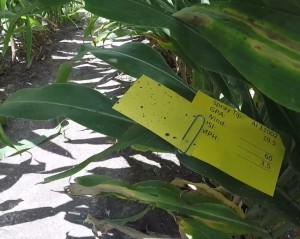Proper application techniques for controlling sugarcane aphids is essential for obtaining adequate control of these insects. The labels for both Sivanto and Transform contain instructions on using plenty of water when treating sorghum fields. Both recommend using 10 gallons per acre or more.
The reason for the higher application volumes is because this aphid tends to populate the lower canopy. Lower application volumes will get less canopy penetration, especially in narrow rows.
Last week, I looked at coverage in the lower canopy using water sensitive paper. We place the papers on the upper surfaces of the leaf below the flag leaf and the lowest green leaf in the canopy underneath other leaves. We sprayed water in a typical application evaluating 6 spray tips and 1 or 2 application volumes per tip ranging from 7 to 19.5 gallons per acre. The tips included hollow cones and a variety of flat fan tips.
On the top of the canopy the percent coverage ranged from 28-70% coverage. All of the leaves on top were covered sufficiently so as not to be of concern for controlling the aphids. However, in the lower canopy, the spray tips provided 2-5% leaf coverage. While no statistical differences were found between application tips, the applications with the lower spray volumes had lower percent coverage values.
Nozzles producing coarse resulted in fewer droplets on the leaves than hollow cone spray tips but these droplets were larger in size. The larger droplets may be an advantage when excessive honey dew is on the leaf.
These results demonstrate the need to make insecticide applications for aphid control at higher spray volumes. Hollow cone nozzles are my preference, but flat fan nozzles at higher spray volumes should be as effective.